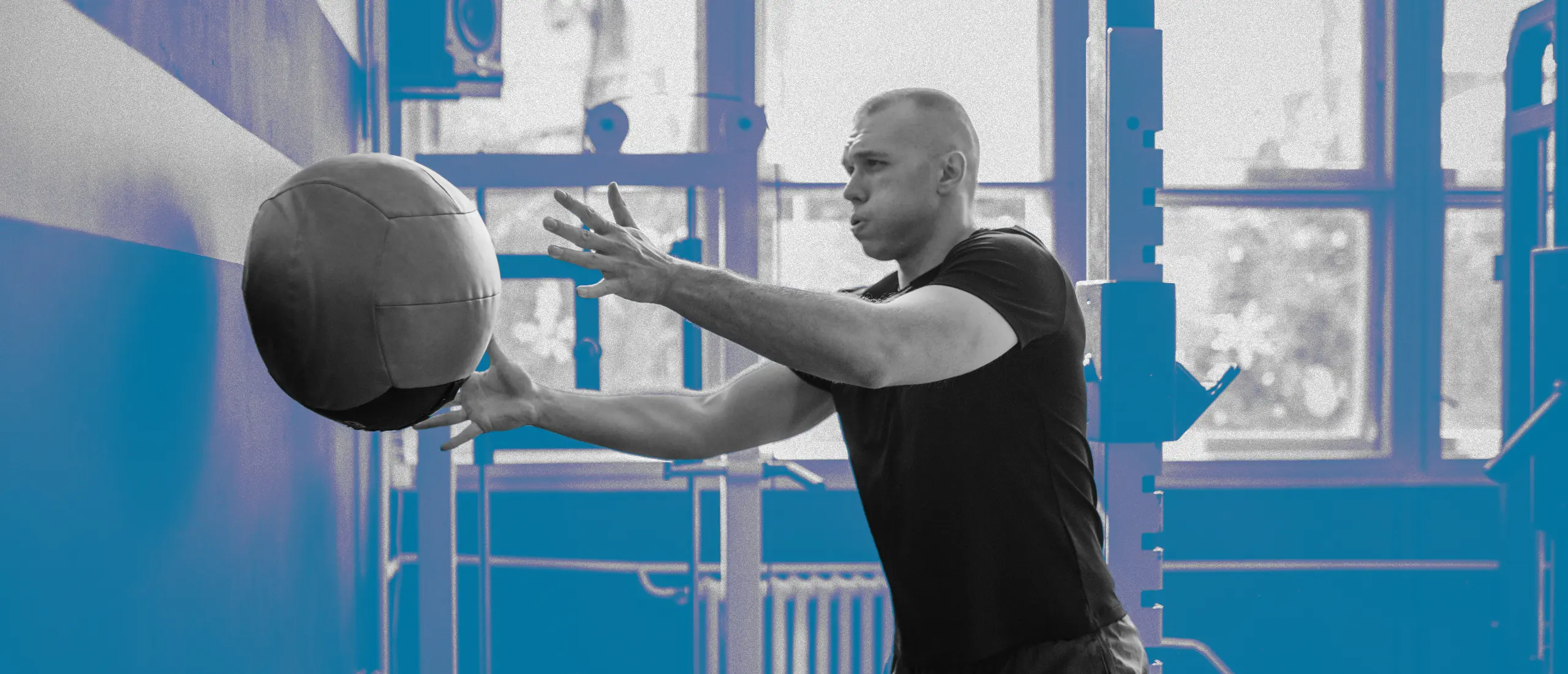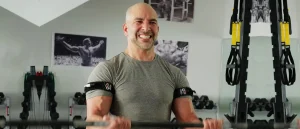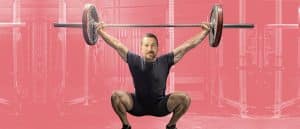If You Want to Live Longer, Make This Tweak to Your Strength Training Routine
We all want to be strong so we can physically do what we want for as long as we’re around. Thing is, opening a pickle jar, carrying the groceries, or following your kids anywhere and everywhere will inevitably get harder. Unless you train for it.
After age 30, muscle loss kicks in. Without regular strength training, you can lose as much as three to eight percent of your muscle mass per decade (1)—slowing down your metabolism, and decreasing your strength and functional fitness (your ability to complete daily tasks with ease).
The good news: Leading longevity experts and exercise scientists say that, by exercising for longevity, you can hold onto your muscle mass and strength. However, a well-designed strength training program should involve training to improve function—or your ability to move both in and out of the gym—too, according to personal trainer Sean Sullivan, CSCS, the Director of Health and Performance at Matterhorn Fit.
Here’s everything you need to know, including exactly how to build a functional strength training routine to move better with age.
The Link Between Strength and Longevity
As you age, you lose muscle in three important ways:
Muscle power
The first thing to go is muscle power (your ability to apply force at speed). While different studies show varying rates of decline, it’s clear that you lose muscle power much more quickly than you do muscle strength or mass (2).
This loss in power is due to a reduction in type 2 (fast twitch) muscle fibers, according to professor and scientist of human performance, Andy Galpin, Ph.D. (the guy that helps longevity doctor Peter Attia, M.D. and neuroscientist Andrew Huberman, Ph.D. fine tune their workouts for longevity). “The atrophy of fast twitch fibers is almost exclusively the problem with aging in muscle,” Galpin told Attia on an episode of The Drive.
Why? Most adults fail to train for muscle power. “If you want to make sure you’re maintaining fast twitch fibers, you have to train intentionally. You can’t accidentally get those,” says Galpin. For example, when was the last time you did a box jump or polished off a round of sprints? Exactly.
You probably don’t care about being able to sprint when you’re 90, but training for power helps to maintain that brain-muscle connection, which can eliminate compensation patterns, and boost strength and function for people of all ages, says Sullivan. As you get older, power is that ounce of pep you need to stand up from a chair, scramble up a rock after your grandkids, lift yourself off the ground when you fall, or generate the foot speed to catch yourself before you fall.
Muscle strength
Strength is a significant predictor of overall health. If all else is equal, research shows that stronger people tend to live longer than weaker people (3).
While it’s tough to assess overall strength, grip strength is widely considered a solid proxy (4). A weak grip has been linked to a higher risk of cardiovascular disease, stroke, myocardial infarction, diabetes, high blood pressure, and all-cause mortality (5, 6). Poor grip strength may also age your body faster. The weaker your grip strength, the older your biological age, per a study published in the Journal of Cachexia, Sarcopenia, and Muscle (7).
“Strength can directly impact the quality of your life,” says Sullivan. You need strength to complete basically every daily activity you do—carrying the laundry, stirring a pot of soup, or walking to the mailbox. And while you don’t lose muscle strength quite as fast as power, if you don’t fight for it, studies show you’ll still lose it at a rate of around 1.5 to 3 percent per year (leaning towards the higher end of that range the older you get) (8).
Muscle mass
Having more muscle mass won’t just help you look better, it’s linked to a longer life (8). According to Attia the link is two fold: “Someone with more muscle mass is less likely to fall and injure themselves, while those who are less likely to fall for other reasons (better balance, more body awareness) will also have an easier time maintaining muscle mass.”
Mass is the last to go. One reason might be that maintaining or gaining muscle mass is relatively easy in comparison to muscle strength or power because it doesn’t require the same precision, per Galpin. Muscle mass tends to respond to a wider range of sets, reps, and weight. Sullivan agrees: “Muscle mass will always be a result of a properly designed training program.”
Why You Should Strength Train for Longevity
Since muscle mass, power, and strength are linked to a longer lifespan and a better healthspan, it comes as no surprise that recent research has connected the dots between resistance training and a longer life.
A review published in The British Journal of Sports Medicine found that 30 to 60 minutes of strength training a week is associated with a 10 to 20 percent drop in the risk of all-cause mortality, cardiovascular disease, and cancer (10). And you don’t have to be strong and powerful, or look like a bodybuilder to reap the benefits. Per the review, as long as your training schedule is regular, strength training offers protection regardless of your strength or muscle mass.
It’s also never too late to start. Research has shown that resistance training can prevent and even reverse the loss of muscle mass, power, and strength that people typically experience as they age (11). One study found that older adults with limited mobility could regain comparable physical function by doing heavy strength training or power training (like plyometrics) at lighter loads (12).
How to Strength Train for Longevity
If you’re ready to kick muscle loss to the curb and improve the way you move for the long haul, get resistance training. Your training routine doesn’t need to be complicated to reap the benefits. In fact, studies show three days a week is a solid bet for building muscle (11).
But if your goal is to boost longevity, your training plan should be specific enough to help you maintain (or ideally improve) mobility, stability, strength, power, and muscle mass as you age. That pursuit requires a bit more intention than your run-of-the-mill three sets of ten reps training plan. Here’s how longevity experts break it down.
First six months
Clear up existing injuries
“A good workout program should always start with clearing dysfunction first,” says Sullivan. “Stacking more dysfunction on top of pain or poor movement patterns is a recipe for disaster.” Work with a physical therapist or chiropractor to clear up any lingering acute, chronic, or recurring injuries to improve function from the ground up.
Build foundational strength
Take the first few months to focus on foundational movement patterns—compound exercises moves like goblet squats, Romanian deadlifts, overhead presses, bent over rows. Galpin suggests making each session full body—splits like a PPL split or bro split are too easy to miss a day (and thus, a muscle group). Per Galpin, all you need is 30 minutes three days a week to knock out one to three working sets of four exercises.
Focus on form
“We need to change our approach so that we are focused on doing things right, cultivating safe, ideal movement patterns that allow our bodies to work as designed and reduce our risk of injury,” Attia wrote in his book Outlive. Think about it: If you’re nursing an injury, that’s weeks, months, or even years shaved off your progress. “Better to work smart than too hard,” he adds.
Galpin’s advice: “Don’t track progression.” While you’ll eventually depend on progress for making strength and power gains, focusing on progression too soon is a recipe for injury. You’ll also want to avoid slow eccentric movements (or the lowering phase of an exercise) which ramp up muscle soreness—which is already at an all time high when picking up a new strength training routine. Focus on proper breathing, and moving with good form instead.
Prioritize stability
Attia argues you’ll need stability before lifting heavy or moving explosively. Why? Stability is the secret sauce that allows you to create the most force in the safest manner possible. By slowing down to focus on stability, you’ll learn how to control your body. That control means once you add load to your strength workouts, you’ll be able to move better and lift heavier, faster. You’ll also reduce the risk of injury to your joints, especially your vulnerable spine.
There’s no one-size-fits-all approach to stability training because it’s about targeting your body’s individual areas of weakness, Attia notes. He’s a fan of anti-extension core training. “If you slouch at a desk all day, you’re probably neglecting your upper back and posterior chain (muscles on your back side like your glutes and hamstrings),” says Sullivan. Focus on strengthening them, increasing range of motion in your hip flexors (through stretching and mobility work), and learning how to properly fire your glutes (mind-muscle connection is helpful here).
Next six months and beyond
At this stage, Galpin recommends breaking each workout down into different sections to cover muscle power and strength. You can stick to three sessions a week but since you’ll be pushing your body harder and faster, you’ll need more rest. Plan to allocate a bit more time to each session, somewhere in the ballpark of 60 minutes.
Train for power
“Anyone at any age is capable of doing plyometrics, ballistic movements, overspeed eccentrics, potentiation clusters, etc. to improve rate of force development,” says Sullivan. It’s just a matter of finding the exercises you feel confident performing, and ramping up from there.
At the beginning of every workout (after a warm up, of course), Galpin recommends devoting ten minutes to power training. It’s pretty straightforward to build lower body power—sprints, jump squats, explosive step ups, box jumps, or jump roping will get the job done.
Haven’t sprinted in, well, maybe ever? No sweat. Galpin recommends just going through the motions at first. Hop on the treadmill, and pick up the speed to around 70 percent of your max effort—it should feel fast like a stride, but not unsafe. Scared to try box jumps? Start with a shorter box. Galpin suggests landing on the box rather than the ground; this reduces the eccentric control needed to descend but not the explosive power to get off the ground.
Upper body power exercises are harder to come by, but Attia swears by med ball exercises—try med ball slams or horizontal throws. If you’re not a fan of structured exercise, pickleball or badminton will do the trick, per Galpin.
Lift heavy
After plyos, Galpin heads straight into his strength workout with his muscles nice and warm. Once you’re comfortable in the weight room he recommends varying rep and set ranges throughout the week to accommodate for both muscle strength and mass gains, while giving your body plenty of time to recover. Here’s how he breaks it down:
|
Focus |
Exercises |
Sets |
Reps |
Load |
Rest |
|
|
Day 1 |
Full Body Strength |
4 |
3-4 |
5-7 |
Heavy |
90 sec |
|
Day 2 |
Full Body Hypertrophy |
4 |
3-4 |
15-20 |
Moderate |
90 sec or less |
|
Day 3 |
Full Body Hypertrophy and Stability |
4 |
3-4 |
Option 1: 5-7 3-second holds |
Heavier than max (pushing against weight as hard as you can but weight should not move) |
90 sec |
|
Option 2: 1 hold up to 5 minutes |
Bodyweight (like planks, wall sits, etc.) |
As for exercises, you can’t go wrong with sticking to compound movements, but feel free to experiment with new variations. Galpin is a big fan of single leg and split stance exercises (like bulgarian split squats or single leg hip thrusts) to even out any muscle imbalances.
Attia likes to focus on building grip strength and eccentric control (which he describes as your ability to “put on the brakes”) simultaneously through exercises like farmer’s carries and weighted step-ups. To increase the eccentric challenge to any exercise, slow down the lowering phase. For example, during step-ups take three seconds to slowly lower yourself to the ground from the top of the step, and get ready to feel the burn.
Be consistent
To maintain power, strength, and muscle mass, “you need to do something, and do it consistently,” Galpin told Attia on The Drive. If you fall off, you’ll be back to square one quick longevity-wise. Mix it up if your interest starts to slip. Challenge yourself with eccentric training, blood flow restriction training, or lifting with resistance bands like Attia. Try Huberman’s unconventional training split. Or go rucking—a Huberman and Attia fan-favorite that might be the easiest way to hit your zone 2 cardio, strength, and build your carrying capacity all in one go.














